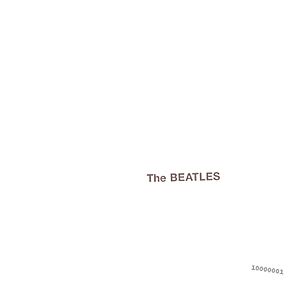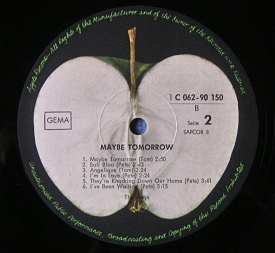Apple Records facts for kids
Quick facts for kids Apple Records |
|
|---|---|
 |
|
| Parent company | Apple Corps |
| Founded | 1968 |
| Founder | The Beatles |
| Distributor(s) | |
| Genre | |
| Country of origin | United Kingdom |
Apple Records is a British record label started by the Beatles in 1968. It was part of a larger company they created called Apple Corps Ltd. The Beatles wanted a way to release their own music and to help other artists they liked.
The label signed many talented musicians, including Mary Hopkin, James Taylor, Badfinger, and Billy Preston. After The Beatles broke up, Apple Records mostly released albums by the former members.
The company was managed by Allen Klein from 1969 to 1973. After he left, Neil Aspinall, a longtime friend of the band, took over. Aspinall managed the label until 2007, when Jeff Jones became the new CEO. Jones left his position in October 2024.
Contents
History of the Label
How It All Started (1967–1969)
After their manager Brian Epstein died in 1967, The Beatles decided to create their own company, Apple Corps. They wanted to have different divisions, like Apple Films for movies and Apple Records for music.
At the time, The Beatles had a contract with the record company EMI. They made a new deal where EMI and its American partner, Capitol Records, would distribute music from Apple Records. This meant EMI would help get the records into stores.
Apple Records owns the rights to all of The Beatles' music videos and films. It also owns the recordings of the other artists who signed with the label.
In its first year, Apple Records signed several exciting artists. The Beatles were often involved in their recording sessions, helping them create their music. Some of the first artists signed were James Taylor, Mary Hopkin, and a band called The Iveys, who later changed their name to Badfinger.
The Allen Klein Years (1969–1973)
By 1969, The Beatles needed someone to help manage their finances. John Lennon brought in Allen Klein, who also managed The Rolling Stones. Paul McCartney was the only Beatle who did not want Klein involved.
Klein took control of Apple and made many changes. He closed some of the less successful parts of the company and removed some artists from the record label. After this, not as many new artists were signed. The ones who were, like Elephant's Memory and Ravi Shankar, were usually brought in by individual members of The Beatles.
Klein's contract ended in 1973. During his time, many of The Beatles' older albums were re-released on the Apple label.
New Management and Reissues (1973–2007)
After Klein left, Neil Aspinall began managing Apple on behalf of The Beatles and their families. The label's distribution deal with EMI ended in 1976.
In the late 1980s, The Beatles' albums were released on compact disc (CD) for the first time. This led to new projects, like the album Live at the BBC and the TV series and album set The Beatles Anthology. The Anthology project was a huge success and helped make Apple Records very profitable again.
In 2006, Apple Records was in the news because of a long legal dispute with the technology company Apple Inc. over the use of the name "Apple."
The Digital Age (2007–Present)
In 2007, Neil Aspinall retired and was replaced by Jeff Jones. Under his leadership, The Beatles' entire music collection was remastered and re-released in 2009. A year later, in 2010, their music finally became available for purchase on iTunes.
When the company Universal Music Group bought EMI, a new company called Calderstone Productions was created in 2012 to manage The Beatles' music catalogue.
The Famous Apple Logo
Where Did the Idea Come From?
Paul McCartney was a big fan of the Belgian surrealist painter René Magritte. In 1967, a friend bought one of Magritte's paintings for McCartney. The painting showed a large, perfect green apple with the words "Au Revoir" (which means "Goodbye" in French) on it.
McCartney loved the simple and powerful image of the green apple. This painting became the inspiration for the logo of Apple Records.
The Logo on the Records
Most records released by Apple had a special design. The A-side (the main song on a single) featured a bright green Granny Smith apple. The B-side showed the same apple cut in half, revealing its core and seeds.
The logo was sometimes changed for special releases.
- For The Beatles' Let It Be album in the United States, the apple was red instead of green.
- George Harrison's album All Things Must Pass had orange apples.
- John Lennon's John Lennon/Plastic Ono Band album had a black and white apple.
- Ringo Starr's single "Back Off Boogaloo" had a blue apple.
- For some albums, like John Lennon's Imagine, the apple was replaced with a picture of the artist.
Zapple Records: A Short-Lived Experiment
Zapple Records was a small sub-label of Apple Records. The idea was to release experimental and spoken word albums. These were meant to be low-cost records, almost like a music magazine.
Zapple was only active for a few months in 1969. Only two albums were ever released on the label:
- Unfinished Music No. 2: Life with the Lions by John Lennon and Yoko Ono.
- Electronic Sound by George Harrison.
Other albums were planned, including one by the writer Richard Brautigan, but the label was shut down by Allen Klein before they could be released.
Famous Artists on Apple Records
Apple Records signed many different kinds of artists. Here are some of the most well-known:
- Badfinger - This band was discovered by a friend of The Beatles. Paul McCartney, George Harrison, and John Lennon all liked their music. They had several hit songs, including "Come and Get It", which was written by McCartney.
- Mary Hopkin - A singer who was discovered on a TV talent show. Paul McCartney produced her early songs, including her biggest hit, "Those Were the Days".
- Billy Preston - A talented keyboard player who worked with The Beatles on their "Get Back" sessions. George Harrison produced his solo albums for Apple, including the hit song "That's The Way God Planned It".
- James Taylor - A singer-songwriter who recorded his first album for Apple. Paul McCartney played bass on one of his songs. This album helped launch his successful career.
- Ravi Shankar - A master of the sitar, an Indian instrument. George Harrison, who was very interested in Indian music, brought him to the label and produced his albums.
- Doris Troy - An American soul singer. She recorded one album for Apple, and George Harrison and Ringo Starr both helped write and play on some of the songs.
- Yoko Ono - An experimental artist who recorded many albums and singles for Apple, often with her husband, John Lennon.
See also
 In Spanish: Apple Records para niños
In Spanish: Apple Records para niños
- Apple Corps v Apple Computer
- List of record labels
- The Longest Cocktail Party, a book about the inside story of Apple Corps




